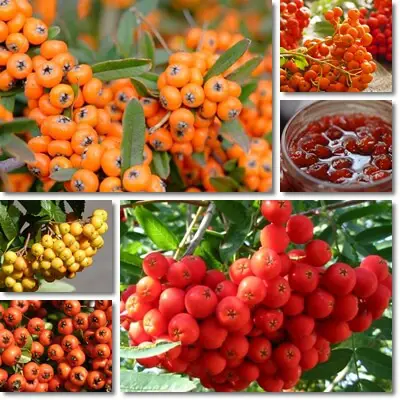Back when apples and pears weren’t as readily available, people would forage for fruits like crabapples, hawthorn, rose hip and rowan berries. Rowan berries, or mountain ash, are bright-colored orange or red apple-like fruit rich in organic acids and antioxidants. Their tart and bitter taste doesn’t render them very popular to eat raw, but that’s good because they shouldn’t be eaten raw any way. Preparations from rowan berries can help get rid of phlegm stuck in the throat, boost immunity and combat nausea, but also promote eye health and skin health, initiating reparative processes at cell level.
What are rowan berries?
Rowan berries are the berry-like fruit of the tree with the same name. They are also known as mountain ash, service tree or sorb berries and, in the case of some species, also whitebeam (e.g. Sorbus aria). There are hundreds of different species of rowan, all of which grow in the cool temperate areas of the Northern hemisphere where they occur, for the most part, naturally. Most, if not all, produce edible, colorful fruits. Despite being called ‘berries’, rowan fruit are actually pomes like apples, pears, crabapples (wild apples), quinces, loquat and also hawthorn berries, aronia and amelanchier or serviceberry.

What do rowan berries look like?
Rowan berries vary in appearance depending on the species, but for the most part, the fruits look like tiny apples or crabapples, although some are pear-shaped too. They are 8-10 mm and up to 2-3 cm long, with thin, smooth skin, sometimes also lenticel spots (the tiny dots or specks on apples, pears and other fruits and tree bark), and a star-shaped tuft at the end opposite to the stem which used to be the sepals.
Typically, rowan berries are bright orange or red in color, sometimes crimson, but there are also yellow varieties (e.g. in ornamental cultivars), bright pink (Sorbus hupehensis, S. sitchensis), pale pink (Sorbus vilmorinii), white (Sorbus glabrescens, S. oligodonta, S. khumbuensis, S. fruticosa) and species with fruits with more than one color, such as green and red, russet and red or white with pink or crimson.
The fruits grow in heavy clusters alongside the fern or feather-like leaves of tall rowan trees.
Are rowan berries edible?
Yes, rowan berries are, for the most part, edible. You can eat rowan berries cooked and they are perfectly safe. You can also eat them raw, but only if previously heat-processed (e.g. heat-dried) or frozen. It’s important to know that fresh rowan berries are a source of parasorbic acid, a natural organic acid that could cause nausea, vomiting, kidney damage and other side effects.
In larger amounts, the raw berries are potentially toxic, so to avoid side effects, they are usually frozen prior to consumption raw, or, even better, cooked.
Rowan berries are not edible just to humans, but also wildlife, birds in particular, sustaining entire populations during fall and winter when food is scarce.
Where it grows in the wild, the rowan tree can become very well established and grow up to 12-14 meters tall, becoming an important source of sustenance for wildlife during harsh winter months.
What do rowan berries taste like?
Rowan berries don’t taste very good as they are, at least not like the typical sweet fruits we enjoy eating on a day to day basis. The raw berries have a tart or astringent taste and can be quite bitter too, with little overall flavor. Some species have little to no juice, making the berries mealy in texture, whereas others are slightly juicier, but not enough to make them palatable raw.
Also, some species produce quite small fruits, with little pulp-to-seeds ratio, making their consumption tedious. The most popular uses for the berries are sweet and sour sauces, jams, jellies or fermented beverages.
Rowan berries are in season roughly from October-November till December, but can stay on the plant all winter and up until early spring. Some species ripen as early as September or even August. The berries are usually best collected after the first frosts, but due to being a popular food source of wildlife, they might not last very long.

Popular uses of rowan berries
For use as food, it’s recommended to gather only berries from selected species, preferably cultivated, so as to avoid confusion with inedible berries.
- Tart and sweet sauces. Rowan berry sauce is typically tart-tasting, but can be sweetened for a more palatable taste.
- Jams and jellies. The fruits are a source of pectin and can be used to make jams and jellies that can be eaten as they are on bread or with butter, or used as pie or pastry filling. After cooking, the fruit preserve will likely need to be strained to remove the seeds. You can add apples or crabapples for extra pectin to better bind the jam/jelly.
- Make tea. You can use the fresh, crushed berries to make tea by boiling them in water for 5 minutes or more, or steeping in hot water for 10-15 minutes.
- Fermented beverages. Rowan cider and wine are popular throughout the Northern hemisphere where the tree grows naturally in the wild. Usually made in a home setting, using traditional recipes or family recipes passed down from generation to generation.
- Traditional rowan berry soup. A popular Southern, Central and Eastern European recipe, made from boiled rowan berries. The soup can be sweetened with honey or sugar, or left tart. It’s eaten as it or with fresh bread. A similar soup is made in June-July from ripe cherry plums or myrobalan plums.
- Freeze. You can freeze the fruits over winter and use when needed for cooking.
- Dry and grind. Dry rowan berries in the oven, separate the seeds from the pulp and skin, and grind the dried pulp and skin for later use as a nutritional supplement. Store in an old vitamin bottle and keep sealed, in a cool, dark place. Also find out more about the uses and health benefits of hawthorn berries.
What are the benefits of Rowan Berries?
- Astringent gargle. An astringent gargle can be prepared from heat-processed rowan berries such as tea to help thin and dislodge thick mucus from the throat. The high organic acid content of the fruit is responsible for helping to get rid of phlegm stuck in the throat (e.g. citric acid, malic acid).
- Antioxidant properties. High in antioxidants such as carotenoids and other flavonoids and polyphenols, rowan berries have a protective effect, scavenging for free radicals and helping reduce and repair cell damage caused by oxidative stress due to free radical action.
- Benefits for eyesight. The bright orange and red berries are a source of carotenoids with vitamin A action and promote the physical health of the eye as well as contribute to visual acuity.
- Immune-boosting properties. Source of vitamins A and C, rowan berries support the immune system function by protecting the integrity of mucous membranes, exerting an anti-inflammatory action and increasing the immune system response by enhancing the activity of several types of white blood cells. However, vitamin C content is impacted by cooking heat.
- Benefits for skin. Vitamin C in rowan berries supports collagen synthesis for more youthful-looking skin and, together with pro-vitamin A carotenoids and other antioxidants, exerts antioxidant and anti-aging effects as well as initiates and supports reparative processes at cellular level.
- Other potential benefits may include: minor benefits for gums and teeth from vitamin C, potential benefits for insomnia as a result of the antioxidant content in the fruits, diuretic properties when consumed as tea, helps combat nausea and may help in instances of low stomach acid due to the high content of organic acids.
What are the side effects of Rowan Berries?
- Risk of toxicity. Raw rowan berries naturally contain an organic acid called parasorbic acid (less than 1% in common species). Parasorbic acid is toxic and can cause side effects ranging from nausea, vomiting, irritated stomach and stomach upset, cramps and diarrhea to kidney damage, depending on intake. For this reason, it’s not advisable to eat rowan berries as they are.
What happens if you eat rowan berries raw? Depends on how many you eat at once and which kind. A few berries will likely not cause serious side effects, if any, but a more significant intake may very well lead to stomach upset and even more severe side effects. It is advisable to either cook the fruit or heat-dry it (e.g. dry in the oven) to render it perfectly safe to eat. You can also pick the fruit after the first frosts, at which point it’s overripe and the parasorbic acid is converted into a safer compound by the freezing temperatures (although cooking does a far better job at that). In any case, make sure you talk to your doctor first.
- Rowan berry for pregnant women. There is insufficient evidence with regards to the safety of rowan berry use during pregnancy. For this reason it is recommended to avoid consumption of the raw berries, fresh or frozen, tea, tincture and other similar rowan preparations while pregnant or nursing.
